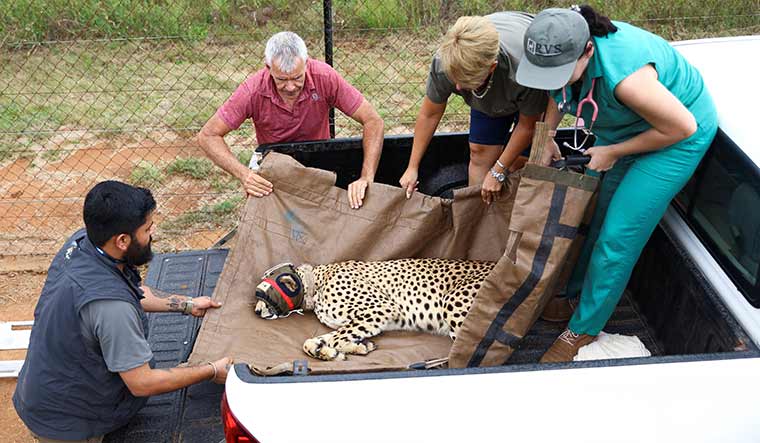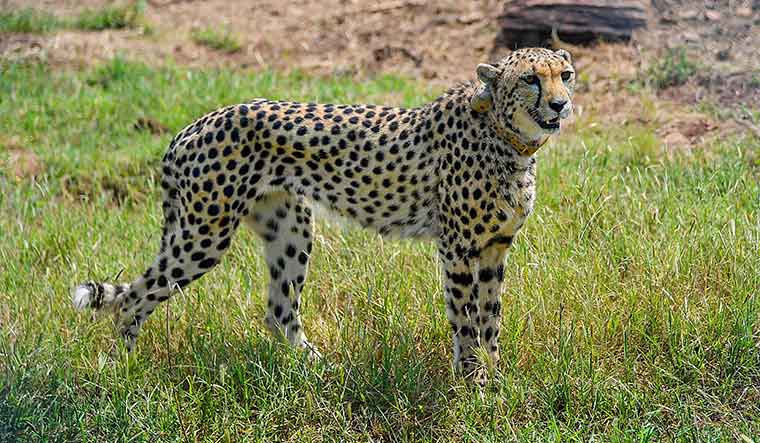EIGHT SEEMS TO be a recurring number for India’s ambitious Project Cheetah, and it does not bode too well for the big cats.
Eight months after the moment of pride and celebration when the first batch of eight cheetahs from Namibia was released in Kuno National Park (KNP) in Madhya Pradesh, the mood has turned sombre with eight of the 24 wildcats dying in the past three and a half months. South African expert Dr Adrian Tordiffe, who is associated closely with the project, said the frequency of the deaths at Kuno was alarming.
Speaking exclusively with THE WEEK, Tordiffe, the top name on the consulting panel of international cheetah experts linked to the Cheetah Project Steering Committee, cautioned that if the situation related to deaths was not turned around, Project Cheetah could be in jeopardy as the South African government might decide against sending more big cats to India. Rajesh Gopal, chairman of the steering committee, however, said such mortalities were expected in the initial phase of the intercontinental translocation project. The National Tiger Conservation Authority (NTCA), which is the project implementation agency, too, was against the “premature conclusion on the success or failure of the project as it has not completed even one year”.
Project Cheetah was launched on September 17, 2022, when Prime Minister Narendra Modi released eight cheetahs from Namibia into KNP, 70 years after the sleek cats were declared extinct in India. On February 18, 12 more from South Africa were flown in. Tordiffe, veterinary wildlife specialist from the University of Pretoria, had accompanied both the Namibian and the South African cheetahs to Kuno.
Four of the 12 cheetahs from South Africa are now dead, along with one adult from Namibia and three cubs of a Namibian cheetah. Tordiffe said there was real concern about the lack of involvement of experts in the project and delays in providing information. “We are willing to help and provide advice. We are not trying to tell Indian authorities how to do everything, but at this stage they really need inputs from us, otherwise the project is in jeopardy,” he said.
Referring to the latest deaths of the two cheetahs named Suraj and Tejas, Tordiffe said, “The veterinary staff at Kuno failed to correctly diagnose the cause of death. They also did not make any attempt to communicate with us. We only got partial information about the case until I was sent the video of the second male cheetah that died on July 14. I asked to participate in the steering committee meeting that was held in New Delhi, but my request was ignored. The Kuno management does not consult international experts,” he said.
 Ready to go: A cheetah is loaded into a truck before being flown to India from South Africa | Reuters
Ready to go: A cheetah is loaded into a truck before being flown to India from South Africa | Reuters
Tordiffe warned that the continuing deaths and the failure to consult experts from host countries might prove detrimental. “We have to defend this project before our own governments to ensure that we can continue to supply cheetahs to India,” he said. “If things go wrong in India and our government decides that it is too risky to send more cheetahs, then we are in for a real problem. The project will actually be dead. We want to transport additional cheetahs to India sometime next year, and for that to happen we have to turn this situation around.” Tordiffe said the South African government was still supportive of the project, but if there was too much negative publicity and poor cooperation from India, it might change. The expert later added that he had a discussion with NTCA officials and was assured of better cooperation.
Suraj died on July 14, and prima facie evidence pointed to the wounds on his neck and back. Tejas died on July 11, from “traumatic shock”, according to Kuno authorities. Postmortem examination showed that Tejas’s internal organs were severely compromised and that he weighed only 43kg, compared with the average weight of 55kg to 60kg of similar cheetahs.
After seeing the video of the postmortem examination and learning about the details, Tordiffe said both cheetahs appeared to have died from complications related to their satellite collars and the heavy rainfall at Kuno in recent weeks. He said there was severe skin infection on Suraj’s neck and maggots on his wounds. “The wounds that I saw in the video were almost certainly not caused by another animal, but by a problem that we did not foresee because we put collars on cheetahs in Africa without any problem. But the wet weather extending over several days during the monsoon in India seems to have caused a real problem. The moist skin under the collar got infected, attracting flies and fly larvae. They invaded the wounds and made them deeper, spreading along the back of the animal. Since the wounds were on a part of the body that the cheetahs could not lick and clean, there was the invasion of bacteria which spread through the body to cause septicaemia (blood poisoning) and ultimately shock, leading to death.”
Tordiffe suggested an immediate assessment of all the cheetahs at KNP to find out the extent of the problem. He suspects most cheetahs are affected. In that case, he suggested long-acting insecticide treatment administered through darts. “But it will protect the animals only for two weeks and will not help the inflammation of the skin caused by bacterial infection. Antibiotics could be used, but is not recommended for repeated use until the end of monsoon. The final solution might be to remove the collars of the affected cheetahs and bring them into the acclimatisation camp for monitoring without collars,” he said. The apprehension turned out to be right as by July 17, three more cheetahs were found to have neck wounds.
Two other experts―Dr Laurie Marker, founder of the Namibia-based Cheetah Conservation Fund, and Vincent van der Merwe, manager of the Cheetah Metapopulation Project, South Africa―were also of the view that Tejas and Suraj died from septicaemia caused by collar wounds. They said the wet weather made the skin moist and prone to infections.
Indian authorities, however, said the situation was not alarming. Rajesh Gopal said that in such a venture one should be prepared for mortalities. He said, “Our action plan mentions that the mortality rate may even go up to 90 per cent (of the founder population).” He added that the cheetahs were fragile animals and that the international translocation had changed their biological clocks and circadian rhythms. “They have to get used to this and also to the anti-predator strategies of the prey animals in the new areas, the forest cover and the presence of other competitive animals. They do this through exploration. The Kuno cheetahs are currently in that exploratory phase. In this phase, there might be wrong turns and they can get killed or die. Only finally when they call out their territories will they settle and stabilise. This can take at least three or four years,” said Gopal. “Collar-related deaths are unusual and require more studies to find the exact cause. Meanwhile, other animals need to be examined urgently and possible preventive measures taken,” he said. Currently, 11 of the 15 adult cheetahs are in the wild, while four adults and a cub are captive in quarantine enclosures. Capturing the animals in the wild for examination might prove to be a difficult task. At the time of writing this report, staff at KNP are engaged in the task.
Gopal also confirmed that Suraj’s death was caused by bacterial infection related shock and that his body was full of maggots. Infighting, violent interaction with other animals and poaching were ruled out because of the absence of evidence. Gopal speculated that infection-related shock might have killed Tejas, too. Earlier, the cause was believed to be wounds from violent mating, but that no longer seems possible.
Gopal said collars themselves could not cause infection, though they might aggravate the condition. Also, he did not agree to the theory that rainy weather might have caused the problem. In his work of a lifetime with collared tigers, Gopal said he had not seen any such problem. “But since these animals have been brought in from a different continent, we need in-depth studies to find out the exact cause of the infection,” he said.
As a speculative theory, Gopal said the cheetahs might have been infected by some disease-causing organisms found in the local livestock, causing any small wound to deteriorate. This is more likely because the agro-pastoral system (livelihood system integrating crop and livestock production) around the national parks and sanctuaries, which is typical to India, is not so common in countries like Namibia and South Africa. He also mentioned that during the steering committee meeting on July 15, the possibility of managerial lapse was ruled out. “There are nine personnel monitoring each of the cheetahs and it is quite adequate. We cannot be more intrusive than that.”
Responding to Tordiffe’s accusation that he was not allowed to attend the steering committee meeting, Gopal said all members and experts were sent the link for the online meeting. He also contested the point that international experts were not consulted, saying that although the KNP had a team of eight or nine veterinary experts, consultations with international experts were made as and when required, but not for all routine things.
The NTCA has come out with a detailed note related to the deaths. It said the project was yet to complete a year and it would be premature to conclude the outcome in terms of success and failure. It denied that the deaths were caused by radio collar wounds and stressed that all the deaths were natural. The report said blaming the deaths on radio collars was not based on any scientific evidence.
“Global experience suggests that in the initial phase of reintroduction of cheetahs in African countries, there was more than 50 per cent mortality. The mortality may happen because of intra-specific fights, diseases, accidents before release and post release, injury caused during hunting of prey, poaching, road hits, poisoning and attacks by other predators,” said the note. Considering all these eventualities, an action plan has been made, with a provision to bring in new cheetahs annually to manage their demographic and genetic composition. The NTCA also revealed that it is consulting international cheetah experts and veterinary doctors from South Africa and Namibia for investigating the cause of deaths.
Wildlife activist Ajay Dubey, however, said that some concerns still existed. “The Madhya Pradesh forest department’s note on the death of Suraj showed that the monitoring team noticed the cheetah to be sluggish and that there were flies around it at 6:30am, but the doctor could reach the animal only by 9am. Similarly, whenever there is an emergency medical situation, veterinarians from Bhopal and Jabalpur, which are very far from Kuno, rush there. This shows a lack of expert vets on the ground,” said Dubey. He also mentioned that Uttam Sharma who runs KNP also had the charge of the Madhav National Park in Shivpuri (120km from Kuno), where two tigers were recently released.
Bhupender Yadav, Union minister for environment, forests and climate change, told journalists that the government was in touch with experts, including international experts, to review the situation. “We are aware of all the concerns and would deal with them with sensitivity,” he said.
Yadav ruled out shifting the cheetahs out of Kuno. “They will not be relocated,” he said. “We will take the best measures here and we are sure that the cooperation of the people of Madhya Pradesh and the hard work of the officers will pay off and bring good results. I am hopeful that the project will be successful.”
Trouble in the jungle
September 17, 2022 8 cheetahs (5 females and 3 males) from Namibia released in Kuno.
February 18, 2023 12 cheetahs (5 females and 7 males) from South Africa released.
March 23 Jwala from Namibia delivers four cubs.
March 27 Sasha from Namibia dies, likely of renal infection.
April 23 Uday from South Africa dies, likely of cardio-pulmonary failure.
May 9 Daksha from South Africa dies, likely of injuries due to violent mating.
May 23 One of Jwala’s cubs dies.
May 25 Two more cubs of Jwala die–all three deaths likely because of low birth weight and severe dehydration caused by extreme heat.
July 11 Tejas from South Africa dies due to “traumatic shock”. He was underweight and his internal organs were compromised.
July 14 Suraj from South Africa dies of septicaemia caused by wounds on neck and back, and consequent shock.




